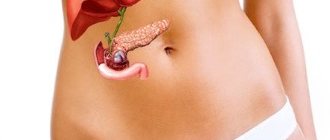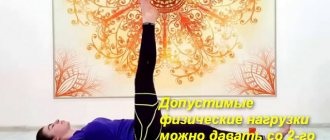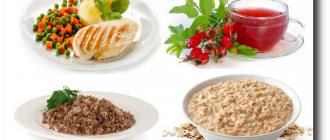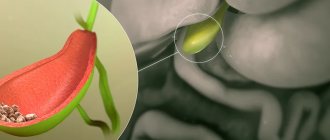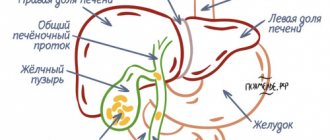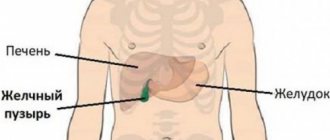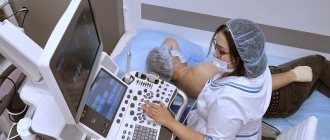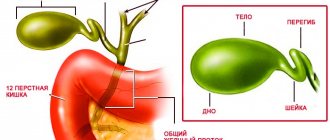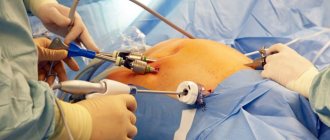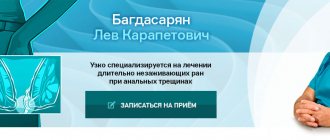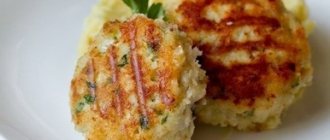General rules
Regardless of which cholecystectomy is used - laparoscopy or traditional open cholecystectomy, diet in the postoperative period is the most important component of the treatment and recovery period, and the first days after surgery are especially important.
After the operation, it is strictly forbidden to drink any liquid for 4-6 hours. It is only allowed to wet the patient’s lips with water, and a little later (after 5-6 hours) it is allowed to rinse the mouth with herbal infusions.
After 12 hours and until the morning of the next day after surgery, you are allowed to drink still water every 10-20 minutes in small portions (1-2 sips) with a total volume of no more than 500 ml.
On the second day, low-fat kefir, unsweetened tea, and jelly are introduced into the diet (volume up to 1.5 l/day). Serving – no more than ½ glass. Frequency of administration – 1 time/3 hours.
On the third/fourth day, the patient is allowed to eat: semi-liquid mashed potatoes, pureed soups in vegetable broth, egg white omelet, grated boiled fish, fruit jelly and 1 teaspoon of low-fat sour cream. Meals up to 8 times a day, in portions of 150-200 g. From liquids, you can drink juices (apple, pumpkin) and tea with sugar.
On the fifth day, biscuits and dried wheat bread (no more than 100 g) are introduced into the diet.
On days 6–7, pureed porridge (buckwheat, oatmeal), boiled chopped fish and meat, low-fat pureed cottage cheese, vegetable puree, and fermented milk products are introduced.
On the eighth day after laparoscopy of the gallbladder, depending on the severity and prevalence of symptoms of the main, concomitant or complicating disease, Diets No. 5A , 5 , 5P (1 or 4 groups) are prescribed. As an option, Diet No. 5Sh (described in the “varieties” section).
Basic diet after gallbladder removal - Table No. 5 and its variations. In case of a pronounced inflammatory process, an anti-inflammatory option of table 5 - Diet 5B - . Its peculiarity is the limitation of the amount of food taken. The calorie content of the diet is 1600-1700 kcal (55-65 g protein, 40-50 g fat, 250 g carbohydrates).
All dishes are served exclusively pureed without broth or the addition of butter: various types of slimy cereal soups, semi-liquid pureed porridges with the inclusion of a small amount of low-fat milk, jelly, pureed compotes, vegetable juices. Next, include in the diet in small quantities carefully pureed steamed meat, boiled fish, low-fat cottage cheese, crackers or dried wheat bread.
Meals after removal of the gallbladder at least 5 times, in fractional portions, about 200 g, without salt, with plenty of liquid (about 2.5 l/day). Next, on days 8-10 the patient is prescribed Diet 5A and then Diet No. 5 .
Diet No. 5 refers to physiologically complete nutrition and is intended to normalize the process of bile secretion and reduce cholesterol in the blood. Small and frequent (5-6 times/day) meals are recommended, which promotes the outflow of bile. In order to enhance the secretion of bile, vegetables are introduced in the form of vinaigrette and salads, seasoned with unrefined vegetable oils.
Almost all easily digestible carbohydrates are sharply limited in the diet, since their intake contributes to the development of bile stagnation (sweets, jam, sugar, honey) and vegetables that contain oxalic acid and essential oils in large quantities (sorrel, spinach, citrus fruits).
In order to stimulate bile secretion, the diet includes vegetables, berries and fruits, and chicken eggs (at least one). The calorie content of the diet is 2800-3000 kcal (100 g proteins, 90 g fats, 450 g carbohydrates). Salt consumption at the level of 8-10 g, liquid - 1.5 liters.
With cholelithiasis, concomitant diseases of adjacent internal organs often occur - the duodenum, pancreas, biliary tract: duodenitis , cholangitis, pancreatitis , dyskinesia . And often against this background, after cholecystectomy, postcholecystectomy syndrome develops ( dysfunction of the sphincter of Oddi ), which is accompanied by the constant release of low-concentrated bile into the lumen of the duodenum with the further addition of pathogenic microflora and the development of inflammation of its mucosa, which leads to pain, indigestion and intestinal disorders. These consequences of bladder removal are also corrected by nutrition.
In this case, it is necessary to reduce the process of bile secretion, which is achieved by reducing the amount of fat to 60 g by completely eliminating any solid animal fats and vegetable oils from the diet. Raw fruits and vegetables, fatty meat/fish, smoked and spicy foods, onions, radishes, garlic, radishes, and strong broths based on meat/fish/mushrooms are completely excluded from the diet. The consumption of extractives, easily digestible carbohydrates, coarse fiber, table salt and liquid is also reduced to 1.5 liters per day.
For inflammation of the pancreas after cholecystomy, Table 5P .
At the same time, the protein content in the diet is increased to 120 grams and fatty and carbohydrate foods are limited. The total calorie content of the diet is reduced to 2500 Kcal. Avoid hot, sweet, spicy, sour and highly fatty foods that stimulate the pancreas and foods containing a lot of fiber, purine bases and extractives.
Nutrition from the eighth day after surgery
If the patient has already passed a week of the postoperative period, then it is time to switch to therapeutic diet No. 5.
Doctors recommend sticking to this diet for at least 1.5-2 months. Food is prepared by boiling or steaming. You need to eat six times a day and try to stick to a daily eating schedule. In this case, you need to drink about one and a half liters of liquid per day. Allowed dishes for therapeutic diet No. 5:
- Lean meat and fish in the form of soft soufflé, boiled pieces, steamed cutlets, meatballs;
- Steam omelet (be sure to remove the egg yolk before cooking);
- Vegetable, cereal, and milk light soups;
- Cereal, well-mashed porridges, which can be cooked exclusively with water or milk;
- Vegetable purees (including potatoes);
- Steamed cottage cheese casseroles;
- Diluted fruit jelly, juices;
- Vegetable stew;
- Baked apples;
- Dried bread, crackers, Maria-type biscuits;
- Durum pasta.
Diet No. 5 is characterized by a reduced fat content (with the absolute exclusion of refractory fats) and limited carbohydrate content. At the same time, the amount of protein in food remains normal.
Sample daily menu for diet No. 5:
- 8.00 - steam omelette, buckwheat porridge, tea;
- 11.00 - 5% cottage cheese, rosehip decoction;
- 14.00 - oatmeal soup with permitted vegetables, mashed boiled beef soufflé;
- 17.00 - baked apple;
- 20.00 - boiled white fish in pieces, pumpkin puree;
- 22.00 - berry jelly.
The duration of stay on diet No. 5 is determined by the doctor, taking into account the tolerability of such therapeutic nutrition and health status.
Doctors recommend that some patients eat according to dietary table No. 5 for 1.5-2 months, and other patients - for a whole year. After this, if there are no contraindications, you can gradually expand the menu. But at the same time, it is necessary to adhere to the basic nutritional principles of dietary table No. 5, and also avoid prohibited foods. After switching to a common table, a person can already eat low-fat cabbage soup, pickles and beetroot soups, non-rich broths prepared with chicken, steamed meatballs and cutlets. There are many recipes for interesting dishes made from permitted products. All you have to do is put in a little effort and your diet will become varied and tasty!
Varieties
After cholecystectomy, with hypermotor dyskinesia of the biliary tract or with concomitant pancreatitis , duodenitis , a gentle diet is prescribed (No. 5Sh). It is used for 14-21 days until pain and dyspeptic symptoms . Then the patient is transferred to Diet No. 5 .
General characteristics - reduced calorie content to 2000 - 2200 Kcal by limiting the consumption of fats (vegetable oil and also foods rich in cholesterol ). The consumption of easily absorbed carbohydrates is also reduced in the diet.
Products containing purines, nitrogenous extractives, and coarse fiber are completely excluded from the diet. Easily digestible proteins are not limited. The amount of salt is no more than six grams. Food is prepared by steaming or boiling.
Drinking regimen - up to 2 liters of liquid per day. Five meals a day, portions no more than 200 g with one fasting day per week. Chemical composition: 90 g proteins, 60 g fats (vegetable fats excluded), 300 g carbohydrates.
If bile stagnation occurs after laparoscopic cholecystectomy against the background of hypomotor dyskinesia, a lipotropic-fat diet ( No. 5 L/F to enhance intestinal motor function and stimulate bile secretion . The total caloric content of the diet is about 2600 kcal.
The dietary features of this diet include a high fat content (50% should be vegetable oils), a reduced content of simple carbohydrates (up to 300 g) and a slight increase in protein (up to 100 g). The diet includes lipotropic protein products (lean meat, egg whites, fish, cottage cheese), wheat bran, refined vegetable oils, and vegetables.
Butter dough, whole milk, refractory animal fats, and spices are completely excluded. The consumption of extractive substances (meat/fish broths) and foods containing cholesterol is sharply limited. Food is baked or boiled, oils are added exclusively to prepared dishes, chopping is not necessary.
Diet one month after surgery
People who have undergone cholecystectomy are recommended to adhere to the basic version of diet 5 for 1-1.5 years after surgery. After this, relaxation is possible, for example, switching to diet number 15, but an individual approach and consultation with a gastroenterologist are required. It is necessary to keep the consumption of sweets, animal fats, eggs, and milk under special control.
In case of malfunctions in the digestive system, a review of the diet with the help of your doctor is required. In some cases, a return to diet 5, 5a or 5sch is possible. To improve digestion processes, your doctor may recommend the use of enzyme preparations, such as Mezim-Forte or Festal.
There are a number of rules that people who have undergone cholecystectomy should adhere to throughout their lives:
- It is necessary to eat 4-5 times a day, avoid long breaks between meals. It is advisable to train yourself to eat food at approximately the same time.
- Portions should be small so that the diluted bile can cope with the incoming food.
- Refractory animal fats should be completely excluded: pork, beef and lamb.
- The main methods of cooking should be boiling, stewing and steaming.
- Drinking plenty of fluids (1.5–2 liters per day) is recommended.
- To avoid dysbiosis in the duodenum, caused by the absence of a gallbladder, regular consumption of fermented milk probiotics is advisable. Eliminating sweets also helps fight dysbiosis.
- If diarrhea worsens, avoiding coffee, tea and other caffeinated drinks helps.
- You can’t eat seeds for the first 3 months, but then you can include them in your diet.
Below are lists of foods allowed and prohibited for consumption after cholecystectomy.
List of permitted products:
- stewed vegetables and vegetable purees
- steamed cutlets and meatballs
- boiled lean meat (chicken, turkey, rabbit, lean beef)
- boiled sausage
- fish
- vegetable soups
- low-fat cabbage soup
- vegetable and fruit salads
- the vinaigrette
- whole milk
- dairy products
- juices
- vegetable fats
- a little butter.
List of prohibited products:
- fatty poultry (goose, duck)
- lamb, pork, other fatty meats
- spicy seasonings
- alcohol
- cocoa
- marinades
- smoked, fried and salted foods
- baking
- sweets
- sweetened carbonated drinks.
Indications
- diet No. 5B - for severe inflammation after cholecystectomy ;
- diet No. 5A - on days 8 - 10 of treatment;
- diet No. 5 - in the recovery stage, after diet 5A ;
- diet No. 5Sh - after cholecystectomy with hypermotor dyskinesia of the biliary tract or with concomitant pancreatitis , duodenitis ;
- diet No. 5L/F - after cholecystectomy against the background of hypomotor dyskinesia to enhance intestinal motor function and stimulate bile secretion;
- diet No. 5P - after cholecystectomy for acute pancreatitis .
Authorized Products
Products and dishes allowed after surgery include: cereal/vegetable soups, day-old wheat bread, wheat bread crackers, dry biscuits, cutlets, fish, lean meat (rabbit, beef, lean young lamb), steamed, boiled chicken in pieces , fermented baked milk, kefir, low-fat whole milk, yogurt, low-fat cottage cheese and dishes based on it (lazy dumplings, casseroles), mild low-fat cheese, chicken eggs or white steamed omelet (one per day), boiled pasta and cereals (oatmeal and buckwheat ), squash caviar, vegetable salads with vegetable oil, greens, vinaigrette, low-fat ham, doctor's sausage, fruit and berry juices, dried fruits, non-acidic fruits and berries, marshmallows, marmalade, black/green tea, rosehip infusion, still mineral water.
Fats of animal and vegetable origin are added to prepared foods.
Table of permitted products
| Proteins, g | Fats, g | Carbohydrates, g | Calories, kcal | |
Vegetables and greens | ||||
| eggplant | 1,2 | 0,1 | 4,5 | 24 |
| squash caviar | 1,2 | 7,0 | 7,4 | 97 |
| cabbage | 1,8 | 0,1 | 4,7 | 27 |
| broccoli | 3,0 | 0,4 | 5,2 | 28 |
| bulb onions | 1,4 | 0,0 | 10,4 | 41 |
| carrot | 1,3 | 0,1 | 6,9 | 32 |
| cucumbers | 0,8 | 0,1 | 2,8 | 15 |
| salad pepper | 1,3 | 0,0 | 5,3 | 27 |
| parsley | 3,7 | 0,4 | 7,6 | 47 |
| radish | 1,2 | 0,1 | 3,4 | 19 |
| iceberg lettuce | 0,9 | 0,1 | 1,8 | 14 |
| tomatoes | 0,6 | 0,2 | 4,2 | 20 |
| dill | 2,5 | 0,5 | 6,3 | 38 |
Fruits | ||||
| bananas | 1,5 | 0,2 | 21,8 | 95 |
| apples | 0,4 | 0,4 | 9,8 | 47 |
Nuts and dried fruits | ||||
| nuts | 15,0 | 40,0 | 20,0 | 500 |
| raisin | 2,9 | 0,6 | 66,0 | 264 |
| dried apricots | 5,2 | 0,3 | 51,0 | 215 |
| almond | 18,6 | 57,7 | 16,2 | 645 |
| hazelnut | 16,1 | 66,9 | 9,9 | 704 |
| prunes | 2,3 | 0,7 | 57,5 | 231 |
Cereals and porridges | ||||
| buckwheat | 4,5 | 2,3 | 25,0 | 132 |
| oatmeal | 3,2 | 4,1 | 14,2 | 102 |
| rice | 6,7 | 0,7 | 78,9 | 344 |
Flour and pasta | ||||
| pasta | 10,4 | 1,1 | 69,7 | 337 |
| pancakes | 6,1 | 12,3 | 26,0 | 233 |
Bakery products | ||||
| bran bread | 7,5 | 1,3 | 45,2 | 227 |
| whole grain bread | 10,1 | 2,3 | 57,1 | 295 |
Dairy | ||||
| kefir 1.5% | 3,3 | 1,5 | 3,6 | 41 |
| Ryazhenka | 2,8 | 4,0 | 4,2 | 67 |
Cheeses and cottage cheese | ||||
| cottage cheese 1% | 16,3 | 1,0 | 1,3 | 79 |
Meat products | ||||
| beef | 18,9 | 19,4 | 0,0 | 187 |
| rabbit | 21,0 | 8,0 | 0,0 | 156 |
Sausages | ||||
| boiled diet sausage | 12,1 | 13,5 | 0,0 | 170 |
| boiled milk sausage | 11,7 | 22,8 | 0,0 | 252 |
| milk sausages | 12,3 | 25,3 | 0,0 | 277 |
Bird | ||||
| boiled chicken breast | 29,8 | 1,8 | 0,5 | 137 |
| boiled chicken drumstick | 27,0 | 5,6 | 0,0 | 158 |
| boiled turkey fillet | 25,0 | 1,0 | — | 130 |
Eggs | ||||
| hard-boiled chicken eggs | 12,9 | 11,6 | 0,8 | 160 |
Fish and seafood | ||||
| flounder | 16,5 | 1,8 | 0,0 | 83 |
| pollock | 15,9 | 0,9 | 0,0 | 72 |
| cod | 17,7 | 0,7 | — | 78 |
| hake | 16,6 | 2,2 | 0,0 | 86 |
Oils and fats | ||||
| butter | 0,5 | 82,5 | 0,8 | 748 |
| olive oil | 0,0 | 99,8 | 0,0 | 898 |
| sunflower oil | 0,0 | 99,9 | 0,0 | 899 |
Non-alcoholic drinks | ||||
| water | 0,0 | 0,0 | 0,0 | — |
| green tea | 0,0 | 0,0 | 0,0 | — |
| * data is per 100 g of product | ||||
Fully or partially limited products
If the gallbladder is removed, the diet includes the exclusion from the diet of soups with meat/mushroom/fish broth, solid animal fats (lard, cooking fats), goose, duck, fatty pork, smoked meats, most sausages, fresh bread, canned food, dough (butter) , puff pastry), fried or hard-boiled chicken eggs, salted and fatty fish, fried pies, canned fish, whole milk 6% fat, cream, full-fat cottage cheese, sour cream, salted cheese, various seasonings and sauces.
Difficult-to-digest plant foods are limited: all types of legumes, radishes, mushrooms, sorrel, radishes, garlic, green onions, spinach, canned and pickled vegetables. Spicy and fatty snacks, ice cream, confectionery, chocolate, cocoa, alcohol-containing drinks, sour berries, black coffee are excluded.
Table of prohibited products
| Proteins, g | Fats, g | Carbohydrates, g | Calories, kcal | |
Vegetables and greens | ||||
| canned vegetables | 1,5 | 0,2 | 5,5 | 30 |
| peas | 6,0 | 0,0 | 9,0 | 60 |
| chickpeas | 19,0 | 6,0 | 61,0 | 364 |
| beans | 7,8 | 0,5 | 21,5 | 123 |
| spinach | 2,9 | 0,3 | 2,0 | 22 |
| sorrel | 1,5 | 0,3 | 2,9 | 19 |
Berries | ||||
| grape | 0,6 | 0,2 | 16,8 | 65 |
Mushrooms | ||||
| mushrooms | 3,5 | 2,0 | 2,5 | 30 |
Snacks | ||||
| potato chips | 5,5 | 30,0 | 53,0 | 520 |
Flour and pasta | ||||
| vareniki | 7,6 | 2,3 | 18,7 | 155 |
| dumplings | 11,9 | 12,4 | 29,0 | 275 |
Bakery products | ||||
| sliced loaf | 7,5 | 2,9 | 50,9 | 264 |
| buns | 7,9 | 9,4 | 55,5 | 339 |
Confectionery | ||||
| cookie | 7,5 | 11,8 | 74,9 | 417 |
Ice cream | ||||
| ice cream | 3,7 | 6,9 | 22,1 | 189 |
Chocolate | ||||
| chocolate | 5,4 | 35,3 | 56,5 | 544 |
Raw materials and seasonings | ||||
| mayonnaise | 2,4 | 67,0 | 3,9 | 627 |
Dairy | ||||
| milk 4.5% | 3,1 | 4,5 | 4,7 | 72 |
| cream 35% (fat) | 2,5 | 35,0 | 3,0 | 337 |
Cheeses and cottage cheese | ||||
| gouda cheese | 25,0 | 27,0 | 2,0 | 356 |
| parmesan cheese | 33,0 | 28,0 | 0,0 | 392 |
Meat products | ||||
| fatty pork | 11,4 | 49,3 | 0,0 | 489 |
| salo | 2,4 | 89,0 | 0,0 | 797 |
| bacon | 23,0 | 45,0 | 0,0 | 500 |
Sausages | ||||
| smoked sausage | 9,9 | 63,2 | 0,3 | 608 |
Bird | ||||
| duck | 16,5 | 61,2 | 0,0 | 346 |
| goose | 16,1 | 33,3 | 0,0 | 364 |
Fish and seafood | ||||
| salmon | 19,8 | 6,3 | 0,0 | 142 |
| salmon | 21,6 | 6,0 | — | 140 |
| trout | 19,2 | 2,1 | — | 97 |
Alcoholic drinks | ||||
| white dessert wine 16% | 0,5 | 0,0 | 16,0 | 153 |
| dry red wine | 0,2 | 0,0 | 0,3 | 68 |
| vodka | 0,0 | 0,0 | 0,1 | 235 |
| beer | 0,3 | 0,0 | 4,6 | 42 |
Non-alcoholic drinks | ||||
| soda water | 0,0 | 0,0 | 0,0 | — |
| cola | 0,0 | 0,0 | 10,4 | 42 |
| * data is per 100 g of product | ||||
Diet menu after gallbladder removal (Diet)
Below are several menu options for Table No. 5 . It can be modified by observing food processing methods and food preparation technology within the list of products allowed for consumption. Meals are 6 times a day, the diet should alternate between protein dishes (beef, turkey, chicken, fish, cottage cheese) and carbohydrate dishes prepared on the basis of various cereals.
Option 1
| Breakfast |
|
| Lunch |
|
| Dinner |
|
| Afternoon snack |
|
| Dinner |
|
| For the night |
|
Option 2
| Breakfast |
|
| Lunch |
|
| Dinner |
|
| Afternoon snack |
|
| Dinner |
|
| For the night |
|
Option 3
| Breakfast |
|
| Lunch |
|
| Dinner |
|
| Afternoon snack |
|
| Dinner |
|
| For the night |
|
Dish recipes
Dietary food should be as varied and tasty as possible and include all permitted foods. Recipes for a removed gallbladder can be changed according to your tastes and preferences. The main thing is to follow the cooking technology and use only approved products. Below are some healthy recipes.
First meal
Vegetarian oatmeal soup with vegetables
Potatoes, carrots, zucchini, oatmeal or instant cereal, butter/vegetable oil, sea salt.
Prepare broth from finely chopped vegetables. Add oatmeal and cook for another 5-10 minutes. Salt, add herbs and butter.
Chicken puree soup with vegetables
Any seasonal vegetables (broccoli, carrots, potatoes, eggplants), chicken fillet, herbs, salt, sour cream 10%.
Puree soup with vegetables
Boil chicken with vegetables. Grind the meat. Add sour cream to the resulting broth, beat with a blender until pureed, add salt, add herbs and pieces of meat. Serve with toasted bread and finely grated cheese.
Second courses
Fish cutlets
White fish fillet, whole milk or cream, bread, egg, salt.
Soak bread in milk. Grind the fish until minced, add squeezed bread, egg white and salt. Mix the minced meat well. Form cutlets and bake in the oven or boil in a steam bath. You can use mashed potatoes or stewed vegetables as a side dish.
Steam omelette with meat
Eggs, beef (chicken), milk, butter, salt.
Steamed meat omelet
Boil the meat until tender, pass through a meat grinder. Beat the eggs, pour in the milk and mix thoroughly, add salt. Mix the ground meat into the whipped mixture. Pre-grease the mold with butter and pour the egg-meat mixture into it. Steam.
Dessert
Casserole (cottage cheese with berry sauce)
Cottage cheese, eggs, sugar, semolina, butter.
Beat cottage cheese in a blender, add semolina, sugar, eggs, dried fruits. Mix everything. Pre-grease the mold with butter, lay out the prepared mass and bake in the oven for 30-40 minutes. For the sauce, beat any berries in a blender, add sugar. Serve with sauce or jam.
Apples baked with dried fruits
Sour apples, dried fruits, honey, butter.
Apples baked with dried fruits
Wash the apples and remove the core of the apple. Fill the cavity with chopped dried fruits, sprinkle with cinnamon, add a little butter and honey. Bake in the oven until done.
Diet No. 5. What can you eat without fear?
Steamed dishes are recommended
Not all patients clearly understand how diet No. 5 differs from other diets. Doctors are not always able to clearly, clearly and intelligibly explain what foods are allowed and how to prepare them correctly. At the beginning of the last century, therapist Pevzner developed 15 different recommendations for the nutrition of patients depending on their diagnosis.
Read: Diet table No. 5 for children - everything parents need to know
Diet No. 5 is intended for developing a diet for patients with pathologies of the liver, gall bladder, cirrhosis, gastritis and duodenitis. Allowed foods for diet No. 5:
- Bread - only yesterday's bread - rye, white, depending on the patient's preferences. Products made from unsweetened dough with various fillings.
- Soups without frying are best vegetarian or dairy.
- Low-fat fish and dishes made from it. Steamed, boiled or baked.
- Meat – lean poultry, pork, beef, rabbit – stewed, boiled, baked.
- Vegetable oil and butter in reasonable doses.
- Various cereal products - porridge, cereals, casseroles.
- Omelettes, but no more than 1 egg per day.
- Vegetables excluding fried ones.
- Fruits except pickled ones.
- Any drinks - juices, decoctions, jelly, tea, weak coffee.
Prohibited foods on diet No. 5:
- Fried dough - you should forget about pies and pasties.
- Rich meat and fish soups.
- Fatty meat and fish, offal.
- Cream, fatty salty cheeses.
- Some vegetables, pickled foods.
- Hot and fiery spices.
You can add dried fruits to porridges
Don't give up on delicious food! Diet No. 5 is not a death sentence. A large number of dishes have been developed that will provide healthy food and satisfy the refined tastes of any gourmet.
Advantages and disadvantages
| pros | Minuses |
|
|
Adviсe
After removal of the gallbladder, you need to practice reasonable physical activity: morning exercises, walking. In the first six months, intense loads on the abdominal muscles are not allowed. In the first month after laparoscopic cholecystectomy , you are allowed to lift no more than two kilograms. After 6 months there are no special restrictions for natural physical activity.
Sanatorium-resort treatment is recommended no earlier than three months after cholecystectomy.
Many people complain of frequent constipation after surgery. If constipation occurs, we recommend including 6-8 prunes in your daily diet, which should be soaked in a glass of warm water and left overnight at room temperature, covered with a saucer. In the morning, drink all the water and eat prunes (you can do it in two doses).
Why do you need to cut?
The main indication for surgery to remove the gallbladder—cholecystectomy—is cholelithiasis. Also, surgical treatment is sometimes required for cholecystitis.
The stones are disturbing
With cholelithiasis, stones form in the gallbladder or its ducts. In scientific terms - stones. They vary in size and chemical composition. There are those that are less than a millimeter. And sometimes doctors remove stones the size of a chicken egg. It takes anywhere from several months to decades to form gallstones.
Gallstones form for two reasons. Firstly, bile stagnates. Secondly, the quality and consistency of bile changes as a result of metabolic disorders.
The formation of stones is promoted by:
- gluttony;
- hunger;
- irregular meals;
- unbalanced express diets;
- elevated cholesterol levels;
- sedentary work;
- pregnancy;
- some hormonal drugs;
- obesity;
- malfunction of the pancreas.
If the stones are located in the gallbladder itself and do not move, then the person may not even “feel” them. But when the stones move to the neck of the gallbladder, the symptoms will become obvious. This is a bitter taste in the mouth, nausea, vomiting, “lumbago” under the rib on the right.
Gallstone disease is called a lady's disease. This is due to the characteristics of physiology and hormonal levels. Mostly, stones are found in patients who are over 40 years old. However, cholelithiasis is not uncommon in childhood. For a child, the main etiological factors are heredity, abnormal development of the bile ducts, general metabolic disorders, and dietary errors.
Video on the topic
How to prevent the formation of gallstones will be discussed in the program “Live Healthy!”
The stones caused inflammation
Inflammation of the gallbladder is called cholecystitis. The cause of its development may be gallstone disease, however, cholecystitis is often a predisposing factor for the formation of gallstone disease in a patient.
The development of cholecystitis can also be caused by bacterial infection and parasites. The disease also develops against the background of pancreatitis. Other risk factors: congenital pathologies, advanced age, dry food.
The main symptoms of cholecystitis include paroxysmal pain in the right hypochondrium associated with eating.
Patients diagnosed with cholecystitis have their gallbladder removed if the disease is accompanied by cholelithiasis. Acalculous cholecystitis is usually treated with medication. Physiotherapy is also used, sanatorium treatment and a gentle diet are recommended on an ongoing basis.
Why does the entire gallbladder have to be removed just because of one stone? The German surgeon Karl Langenbuch, who first performed cholecystectomy 135 years ago, responded something like this: “The gallbladder is not removed because stones have appeared in it. But because it was he who formed them.”
Comments from nutritionists
After the first month, as a rule, the patient’s diet expands, and many patients begin to break the diet, which causes them to make a serious mistake. A diet after cholecystectomy in the first three months is mandatory, since during this period the functional activity of the digestive organs changes.
After cholecystectomy, during the absence of food in the small intestine, the possibility of bile deposition disappears. At the same time, due to the lack of opportunity for its concentration, the properties of bile change, which affects the function of the gastrointestinal tract. It is these features that are taken into account in the dietary program. Therefore, the question of how long to follow this therapeutic diet can be answered: the minimum period is three months.
The consequences of not following a diet after cholecystectomy can be very serious. Most often, the patient develops postcholecystectomy syndrome with all the ensuing consequences.
Generally speaking, after removal of the gallbladder, you cannot neglect your diet. The diet and diet must be changed forever. Of course, over time, many requirements are simplified, but the basic principles must be respected. This will allow you to optimally maintain liver function and bile secretion, normalize the functioning of the entire gastrointestinal tract and prevent constipation , bloating , and bitterness in the mouth, which are often found after cholecystectomy.
Many women trying to lose weight are interested in the question of whether it is possible to fast if the gallbladder has been removed. No, therapeutic fasting is strictly contraindicated for persons after cholecystectomy. They desperately need fractional meals. In the absence of a gallbladder, there is no natural accumulation of bile - it constantly enters the intestinal lumen, and during fasting and the absence of a food substrate in the intestine, bile will damage the intestinal mucosa. Fasting is for healthy people.
Why do you need a diet?
Unfortunately, losing the gallbladder due to cholecystitis does not get rid of cholelithiasis. The liver continues to work, and the bile, the composition of which has changed long before removal, has nowhere to settle. The risk that it will be intensely secreted, accumulate in the ducts and pose a threat to the functioning of the intestines increases significantly. To prevent this from happening, the patient needs to learn to eat small meals - this is the first and main rule. Under this condition, the bile will be released on time, which will avoid creating dangerous pressure in the ducts and the formation of stones in them, and the intestines will be protected from large releases of bile.
Lifelong dietOver time, the function of the missing organ is taken over by the ducts. But this happens gradually and only if a certain nutritional algorithm is followed. As a rule, it takes about a year before returning to a normal diet with minor restrictions.
Let's consider what rules must be followed in the first days, weeks and months after the body loses its gallbladder, and what special diet number 5 is.
Reviews and results
Reviews from the overwhelming number of patients after cholecystectomy confirm the need and beneficial effect of therapeutic nutrition on the state of the gastrointestinal tract. A therapeutic diet allows the patient to recover faster and normalize their lifestyle:
- “...I was tormented by cholelithiasis for a long period. During an exacerbation, I went to the hospital, but then the stones increased in size and the colic became unbearable. They performed an operation and removed the bladder with stones. They said that diet when removing the gallbladder by laparoscopy is the most important thing in treatment. And now almost 3 months have passed. Everything has more or less returned to normal, however, if there is a sudden violation of the diet (overeating, eating fatty foods, drinking a little), various complications begin. Although I understand that nutrition in the absence of a gallbladder needs to be constantly monitored”;
- “... After the removal of the gallbladder, my diet was very strict. A month later I tried to more or less expand it, but I felt bad. The doctor said that it was too early to switch to a common table. And only a year later I was able to start eating normally”;
- “... For more than a year I followed the diet required after surgery - I did not eat lard, salads with green peas, tomatoes, any dishes with tomato juice, borscht, radishes. It’s been 3 years since the surgery, I eat almost everything. There is no discomfort or pain - life without a gallbladder is quite normal”;
- “... In the hospital, this diet was prescribed. For people with excised gallbladder, this is the solution. So I’ve been sticking to it for the second month now. I think I’ll gradually expand it later”;
- “... The food is healthy and wholesome, it’s not difficult to sit on it, you can endure it, the main thing for me is that there is no pain”;
- “... I cook everything for my husband in a double boiler, I visited the forum, and found a lot of useful recipes and tips. Now the food has become varied, and I have taught my children to eat this way too. This is cool";
- “... The doctor warned that therapeutic nutrition after cholecystectomy should last 5-6 months, and then you can slightly expand your diet. But I couldn’t stand it for six months and after 4 months I switched to a regular diet, but without fried foods.”
Diet in the postoperative period
After removal of the gallbladder, table 5 is recommended
Surgery on the gallbladder will completely unbalance the entire digestive system. Therefore, you must follow all the doctor’s recommendations on nutrition during the postoperative period. First week after cholecystectomy:
- The day of intervention - the first 2 hours are complete rest, the patient is not allowed to eat or drink water. As a last resort, you can wipe your lips and mouth with a damp swab.
- After 6 hours you are not allowed to drink, but you can rinse your mouth with herbal decoctions. The doctor or intensive care nurse will tell you which medicinal herbs to use.
- 2 and 3 days after the intervention - you are allowed to drink rosehip decoction. The total volume of fluid during this period is 1 liter per day. Eating is prohibited, but you can get out of bed and walk.
- Day 4 – fruit compote, jelly, kefir or unsweetened yogurt are introduced into the diet. The total volume of liquid is no more than 1500 ml per day. Solid food is prohibited.
- Day 5 – compotes and fruit juices, a little potato or vegetable puree. If you no longer have the strength to endure it, you are allowed to eat 100 g of white bread crackers without salt and seasonings.
- Day 7 - the diet expands - you can eat any foods except fried, spicy, spicy, fatty foods. Food must be pureed. Meals are fractional.
- Day 10 – solid food is allowed, but general dietary recommendations remain the same.
In the future, your life is about following diet No. 5. A year or two after the intervention, you are allowed to occasionally indulge in prohibited foods.
